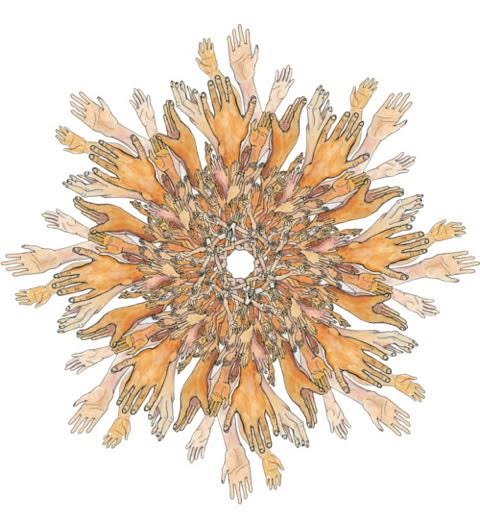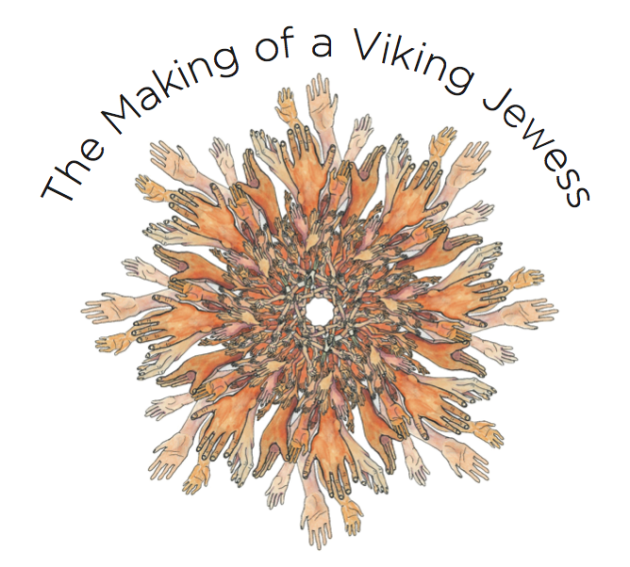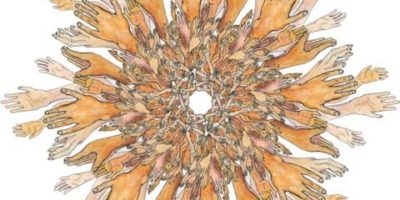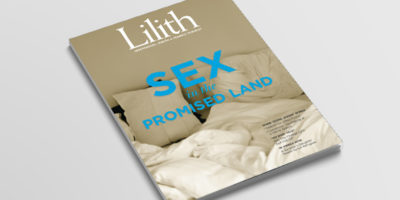
The Making of a Viking Jewess
This Scandinavian socialist embraced her boyfriend’s NRA-supporting, right-wing Orthodox family when she converted to Judaism. After her 25-year marriage comes unglued, her Jewish identity is what sticks.

Art by Jessica Deutsch.
http://jessicatdeutsch.com/
“So, are you going to stay Jewish?” the woman in Starbucks asks. Holy crap, is it possible she thinks I divorced my identity? A wave of indignation mixed with frustration flushes through me. I am in my late forties, and I have been Jewish since, at the age of 23, I immersed in a mikvah to complete my Orthodox conversion a few weeks before I married my Jewish boyfriend.
Before I respond to her, I breathe. I swallow. Be kind. Don’t get emotional I tell myself. “Sure I’ll stay Jewish,” I begin, “it’s not like that’s a switch you can just turn off.” I think I even manage a smile. She smiles back at me. “He’s meshuge to have divorced you for her, and a shiksa to boot! I will tell him so if I run into him!” I cringe. You are so lacking boundaries I think, but I say, “Oh, please don’t. It’s OK, things happen for a reason. And besides, she is good to our kids and they like her.” The woman scoffs, and steps up to place her order.
My Jewish identity was not threatened by my recent divorce as much as was my emotional well-being. While falling asleep at night, I would entertain elaborate fantasies. I can have a partner who will sing “Eyshet Chayil” for me on Friday nights! I could move to Israel and finally become fluent in Hebrew! Or become the writer I had always wanted to be by moving to, say, Maine. I could move back to Norway….
My experience with my extended Jewish family had lasted for nearly 25 years before my marriage ended. My ex-in-law family was an unusual Jewish clan — a loud, fun-loving, tight-knit group of right-wing, N.R.A.-supporting, worried Jewish germaphobes. To them, family was everything, and they protected it —as well as their property — from intruders and strangers with love, dedication and overprotective fervor. My ex-mother-in-law was not your run-of-the-mill Yiddishe mame, because this matriarch carried a .38 in her handbag and could swear like a trooper. Nor was my father-in-law your every day zaydie; he did 100 push-ups and 100 pull-ups in his basement every morning before 5 am, and on his days off he’d be packing a Smith & Wesson in a leather holster, driving a tractor in his fields while smoking cigars. Their greatest enemy, after public schools and their “liberal brain-washing agendas,” was the ubiquitous germ in all its imaginable permutations. Despite their eccentricities, I grew to love them deeply.
It must have been a shock to them when, in the summer of 1985, I — the braless, Scandinavian, nationally programmed socialist that I was at 19 — introduced myself with a firm, confident handshake. I was 5’ 10” tall, fair-haired and blue-eyed, outspoken and independent, and I had decorated my handbag with peace signs, a pink women’s liberation fist, and reminders to “Party Naked!” My guess is they privately hyperventilated, and I don’t mean in the same way their son had when we first met.
I was just about to finish a year in the U.S. as an au pair when we met at the camp resort where my host family and I were spending Memorial Day weekend. He was super-tall, with a dark complexion and a gregarious personality; to me he was both exotic and intriguing. Not to mention fun. We were married three eventful years later.
It was clear early on in our courtship that the fact I was not Jewish posed a major problem for my boyfriend’s family. I remember tears and sobs over long distance phone calls once I returned to my native Norway at the end of the summer. “Religion doesn’t matter,” I would attempt. “It’s that we love each other that is important!” But listening to my boyfriend enumerate his parent’s arguments and concerns, I soon learned about the perpetual concept of ensuring Jewish continuity. I realized that the Jewish identity of a Jewish family could be shaken to the core by the prospect of a non-Jewish daughter-in-law.
Coming from a typical Norwegian Lutheran — but mostly agnostic — family whose main religion was carpe diem, enjoying life and long summer nights on our huge wooden boat on the northern fjords, I approached the matter pragmatically. I told him, “If it takes my becoming Jewish for us to be together, I will do it, rather than live my life without you.” And so what had begun for me as a gap-year experience between high school and university launched a trajectory that would lead me far from home into a life of diaspora, of living in between countries, cultures, families and languages. My parents never once tried to dissuade me. In fact, they encouraged me to fly back to the States to explore the relationship, lest I live my life regretting what could have been. Yet when my dad walked me down the aisle to the huppah in the Orthodox synagogue where my wedding took place, wearing a kippah for the first time in his life, with a violinist in the background playing “Sunrise, Sunset,” he tightened his grip around my arm and whispered, “If you don’t like it, you can always convert back.” Little did he know. Once a Jew, always a Jew.
My early gifts from my mother in-law-to-be — Howard Fast’s The Jews: Story of a People and Chaim Potok’s The Chosen — were but the seeds of what became an interest in earnest. Although not practicing Orthodox Jews, my boyfriend’s family belonged to a small Orthodox shul where a large number of the members were Holocaust survivors and their families, many chicken and dairy farmers originally from Poland. After their rabbi turned me away from conversion the requisite three times, I was accepted as his student, with the caveat that I also enroll in Jewish Studies classes at the university. My readings had prepared me for this “dance of admittance.” Much harder was when, after studying with him for two years and finally presenting myself to the Vaad HaRabbonim (official Orthodox rabbinic committee) of Boston for conversion, they rejected my candidacy. Since I did not readily agree to go to Israel for a year to continue my studies in a yeshiva for women, as they demanded, they feared I was not truly committed to Judaism, but more to my boyfriend.
Thankfully, persistence paid off. After another year of regular classes, both in the rabbi’s study and at the university, I finally became a full-fledged member of the tribe. It must have helped that, while in Oslo for a semester as my grandmother lay dying, I was admitted to join the conversion group at the synagogue there, one known for its strict Orthodox guidelines. Finally, on an early fall day in 1988, dressed in a modest below-the-knee skirt and a white Laura Ashley blouse, I sat in front of three rabbis and answered their questions. What were my feelings about Christmas trees, and about henceforth calling Abraham and Sarah my real parents? Was I ready to observe Shabbat and kashrut even if it might complicate my relationship with my family? I remember feeling nervous but holding my own. This was just the beginning of my Jewish life, I told them. I intended to keep learning and developing as a Jew. They liked that. I dunked in the mikvah while the rabbis stood behind a screen, and as I said my blessings and noticed how surreal the moment felt, they pronounced their “amens” at the sound of the splashing water. With that, and my soon completed degree in Jewish Studies, I had evolved to become a Kosher Viking Jewess. I was adding some welcome material to the gene pool, eventually raising robust Jewish children with a proud Norwegian heritage, and observing Shabbat and holidays. I even used the mikveh for monthly immersions; it was a wholesome deal, and the continuity issue seemed resolved.
Our three sons attended an Orthodox Jewish day school from nursery through 8th grade, and learned to layn and daven and get by in Modern Hebrew. But they also appreciate their Norwegian heritage. They speak Norwegian, are citizens of Norway, will break out and rap in Norwegian as they tote Viking necklaces interlaced with their Stars of David and chais. My husband and I wanted them grounded in both traditions, giving them Thor, Balder and Odin for middle names, and they seem to appreciate the richness of belonging in more places than one. Hopefully, as adults, they will also want to pass their Norwegian heritage on to their children.
Although not observant by any Orthodox standards, my mother in-law taught me by meticulous example not only how to make the clearest chicken soup, the fluffiest matzo balls and the most tender brisket, but also how to prepare the Passover seder, and make the High Holidays meaningful. With me, she gained a third daughter, one who was eager to learn, asking many questions along the way. Soon they went from being kosher-style to kosher, and when I converted they offered me an inscribed siddur thanking me for having enriched their Jewish lives.
Whether it was unique to the in-laws’ brand of compulsions, or more about their discomfort when it came to anything to do with “strangers” — germs included — their fear of many lurking dangers meant that the in-law family lived in an environment defined by language and habits reflecting all the worst-case scenarios that might compromise the clan. I was part of this hyper-vigilant kinfolk for close to 30 years, and I had to work hard at times to not let osmosis influence my own attitude too much. After all, my birth-tribe was stoic, cool-headed northerners who found the expressiveness of more “exotic” tribes to be exaggerated drama, and at times plain overwhelming. Over time, I acquired certain mannerisms and ideas that were not high on my parents’ list of things they admired. I interrupted, complained more openly, obsessed about the minutiae of kashrut and Shabbat and argued adamantly for freedom of public religious expression. I would challenge my parents about their view of the world, and I introduced them to rabbinic thoughts and Jewish philosophy. To help cope with the occasional incongruities of opinions, I would make light of all the meshugas, the in-laws’ and mine, although I also realized my own sense of self was morphing as the years passed. For me, it was a package deal: in order to be a member of their tribe, I bought in lock, stock and barrel.
Twenty-five years went by while my husband and I lived a comfortable suburban life in a relatively diverse community teeming with Jewish life. Twenty-nine synagogues of all affiliations, a bustling JCC, a kosher market and Judaica store, and a public school system that never would question its Jewish students for taking off for any Jewish holidays, great or small. We agreed about making the investment and sacrifices that necessarily come along with the desire to instill a strong sense of Jewish identity in our offspring.
After all the observant practices I had taken on in my life as a Jew — including an Orthodox conversion and wedding, as well as the many daily, weekly, and life-cycle rituals which I loved and that were all very prescribed — I wanted a formal, Jewish termination to our marriage. My ex-husband had no objection. Deciding to divorce after much deliberation — and to divorce in this way — felt like the most independent decision I had ever made, and was critical to my self-definition.
Soon after we had performed the gett divorce ceremony in our rabbi’s study, with the three bearded, ultra-Orthodox rabbis who had driven up from New York City to be witnesses, I was reminded of the increasingly narrow stance the rabbinate of Israel was taking on the kinds of U.S. conversions they accepted. Watching as the bent-over scribe fished out the tattered feathered quill and tiny plastic inkwell from the inside pocket of his black coat, his thin, pale and ink-stained fingers running across the smooth, lined parchment paper spelling out my Hebrew name — Naomi bat Avraham ve’Sarah — I remembered my first conversion rejection in Boston. Everything that had happened in between seemed to flash before my eyes. My marriage and my carefully built Jewish family unit would no longer be what defined me. But I did still have my own Jewish self and my three Jewish sons to move forward with me into the world.
With my Jewish identity in the forefront of my consciousness, the next week I composed a letter to the Rabbinic Council of America, the arbiters of the strictest Orthodox Judaism. I wanted them to re-issue my conversion certificate, since I knew that the Beit Din (rabbinic court) of Hartford that originally converted me had been comprised of three aging rabbis from a generation of Modern Orthodox rabbis known for their (relative) leniency. Embarking on this new chapter in my life, post-divorce, I wanted to re-affirm my commitment to Judaism and at the same time minimize the chances that I or my sons might have our Jewish identities questioned should we chose to make aliyah or marry in Israel. Although it felt humiliating having to “prove” to someone, yet again, how Jewish I had become and how Jewishly I had thus far lived my life, I breathed through it. And I wrote my heart out. Hineini — here I am, I told them.
The new conversion certificate arrived in the mail a few weeks later.
Nina Boug Lichtenstein, a native of Oslo, has a Ph.D. in French literature and teaches English and Jewish Studies. Her book Sephardic Women’s Voices: Out of North Africa is forthcoming. She blogs at VikingJewess.com.



